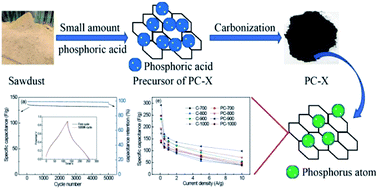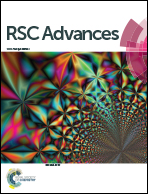Preparation of phosphorus-doped porous carbon for high performance supercapacitors by one-step carbonization†
Abstract
Biomass-derived porous carbon has received increasing attention as an energy storage device due to its cost-effectiveness, ease of manufacture, environmental friendliness, and sustainability. In this work, phosphorus-doped porous carbon was prepared from biomass sawdust (carbon source) and a small amount of phosphoric acid (P-doping source and gas expanding agent) by one-step carbonization. For comparison, parallel studies without phosphate treatment were performed under the same conditions. Benefiting from the addition of phosphoric acid, the prepared carbon material has higher carbon yield, higher specific area and micropore volume. Due to the heteroatom doping of P in the carbon material, the optimized PC-900 sample not only exhibits high specific capacitances of 292 F g−1 and 169.4 F g−1 at current densities of 0.1 A g−1 and 0.5 A g−1, respectively, but also excellent cycle longevity (98.3% capacitance retention after 5000 cycles) in 1 M H2SO4. In addition, the supercapacitor exhibits a high energy density of 10.6 W h kg−1 when the power density is 224.8 W kg−1 at a discharge current density of 0.5 A g−1. This work proposes a sustainable strategy to reuse waste biomass in high-performance and green supercapacitors for advanced energy storage equipment.



 Please wait while we load your content...
Please wait while we load your content...